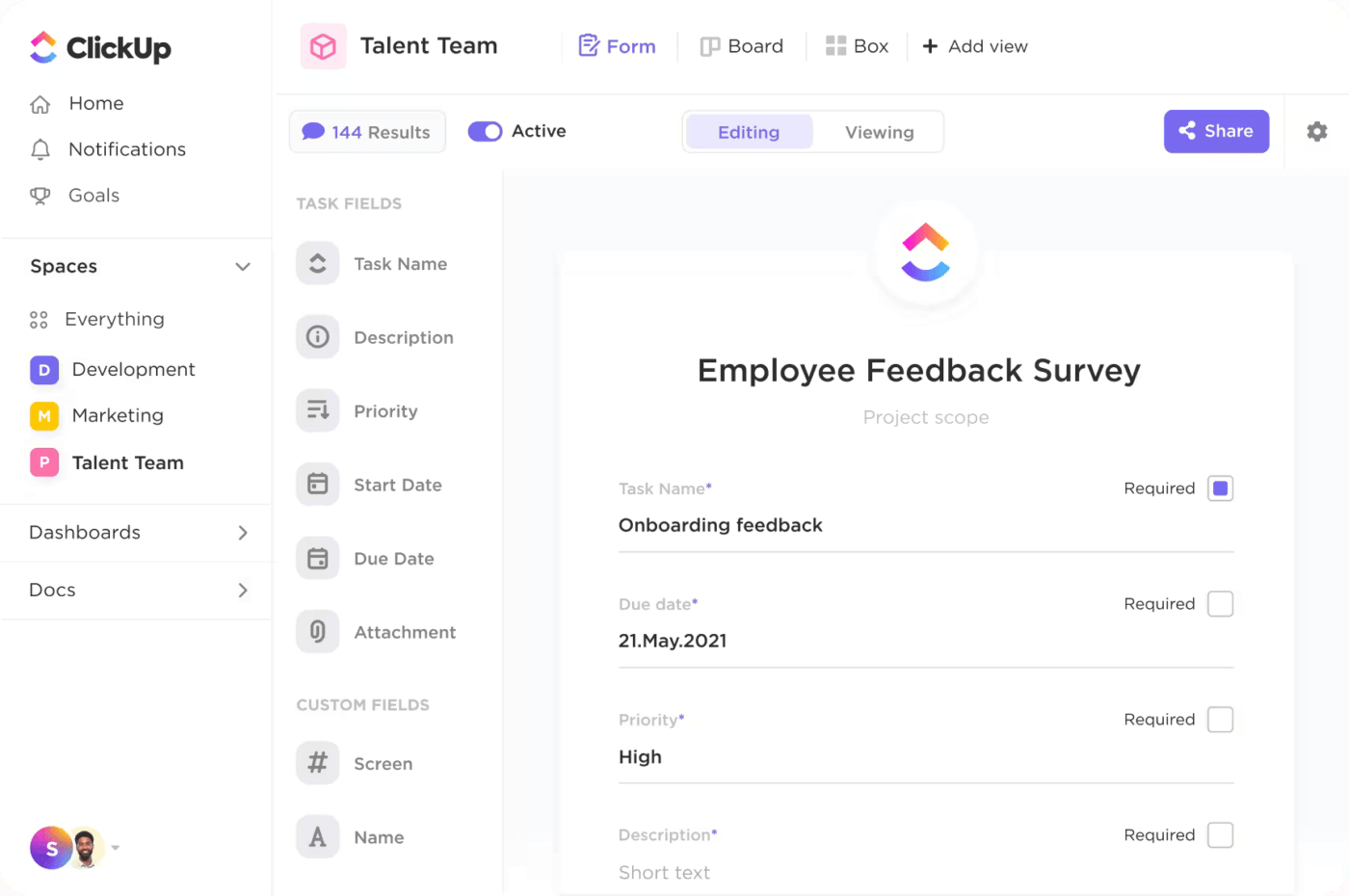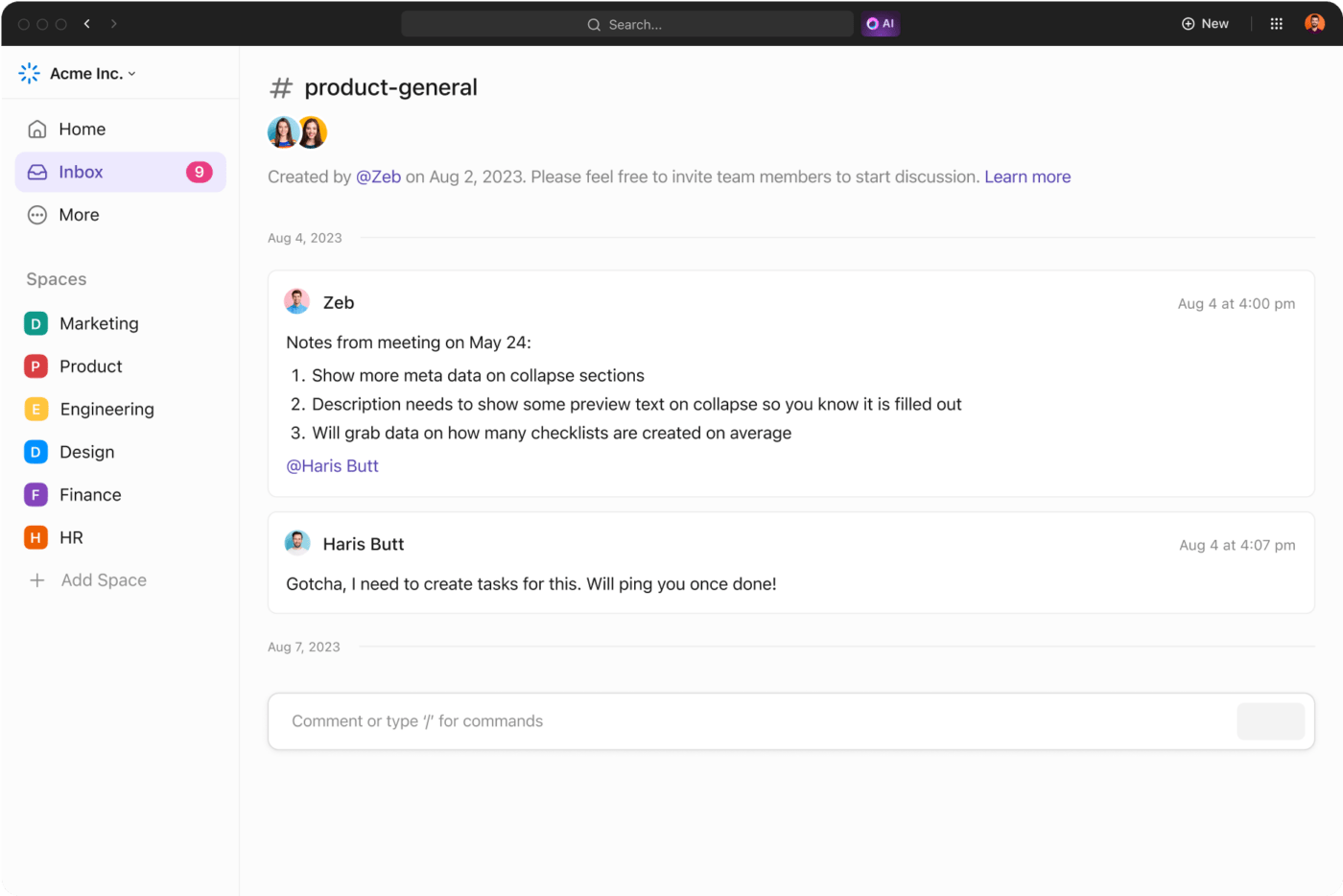Types of Employee Recognition at Work (+ Examples)

Sorry, there were no results found for “”
Sorry, there were no results found for “”
Sorry, there were no results found for “”
Everybody wants to feel seen. In an often stressful and fast-paced work environment, acknowledging employees’ efforts can be vital to their sustained motivation.
Whether you’re an HR manager or a business leader, employee recognition is one of your most valuable assets for helping your workforce feel like they matter. They expect you to recognize their hard work and contributions, and they deserve it, too.
Thankfully, there’s no shortage of options to extend your appreciation.
In this blog post, we’ll discuss the various methods of recognizing employees for their contributions and outline actionable strategies for approaching employee recognition in the most impactful way.
We’ll also explore how ClickUp can be instrumental as an employee engagement software.
But first, let’s start with the basics.
Employee recognition refers to acknowledging and appreciating an employee for their work efforts. It can take the form of cash bonuses, gift certificates, company perks, or even employee appreciation messages, such as verbal shoutouts, thank-you notes, and public praise.
While many tend to associate employee recognition with authority figures, peer-to-peer recognition is just as important. This inclusive method ensures that all employees feel valued, regardless of the organizational hierarchy.
Multiple studies have demonstrated that even a simple acknowledgment of a job well done boosted morale and positively impacted employee engagement.
Recognition also helps enhance their sense of belonging within the team and the company as a whole, motivating them to stay. A well-structured employee recognition program can help you stand out as a top employer—making you likely to attract the best talent.
Different people respond to different types of recognition, so your company’s employee rewards programs should include multiple ways to show their contribution is valued. Let’s talk about various types of recognition that can help boost your team’s morale and productivity.
This involves verbally telling an employee they’ve done a good job or announcing their accomplishment out loud in front of the whole team. It’s a great way to boost employee morale quickly and is most effective immediately after the accomplishment.
For example, you could say, “Great job on that presentation today! Your insights were spot on.” Or, “I want to recognize [employee name] for their excellent work on the recent project. They really delivered!”
Written words of appreciation last longer than verbal praise and may be valued more by the employee. They may even return to the written praise later to feel better when things aren’t going well at work.
Therefore, writing a personal email or even a handwritten note can go a long way. For example, you could say, “Thank you for your exceptional work on the client proposal. Your attention to detail was impressive.”
💡Pro Tip: Highlight your employees’ contributions to a successful project in the internal company newsletter.
This approach refers to a continuous culture of appreciating fellow team members’ contributions.
Whether helping someone with a presentation, answering a tricky client question, or going the extra mile before a demanding project, these efforts deserve to be seen and valued. As a leader, you must model this culture by praising every act that calls for praise.
Informal recognition refers to spontaneous gestures of recognition and are viewed as more personal and authentic.
It could include a thumbs-up or a smile of appreciation, a quick “thank you” during a hallway conversation, or even spot awards like gift cards—check out these corporate gift ideas for inspiration.
Private recognition usually includes one-on-one meetings with the employee to recognize the good effort they put in.
This approach is more suitable for employees who feel shy in public and helps them feel more valued when you talk about their specific accomplishments and approaches. You can either have a scheduled meeting or quickly pull the employee aside to appreciate what they did.
Publicly recognize the employee’s achievement by announcing it to the team, either in person, via email, or through a company communication tool. It’s a great way to celebrate the employee and show that their good work hasn’t gone unnoticed.
For example, you could email the entire company recognizing the employee’s achievement. This would motivate the rest of the team to keep striving toward their accomplishments.
This type of recognition comes from everyone on the team, regardless of designation. When someone verbally compliments a job well done, it creates an atmosphere of goodwill and mutual appreciation.
Peer-to-peer recognition is also a good way to recognize off-the-job activities like covering for an employee who had an emergency or helping someone through a personal problem.
To make it easy for peers to acknowledge each other, you can create a bulletin board with Post-it notes or set up a channel on the company intranet dedicated to shoutouts. Give peer feedback examples for your team to follow.
💡Pro Tip: ClickUp’s Printable Free Kudos Card Template lets you make a digital ‘KUDOS Wall’ for your team. It’s a simple, personalized, and elegant approach to recognizing individual accomplishments, congratulating teams for project successes, or even promoting inter-departmental collaboration.
Acknowledging the efforts of teams and frontline leaders through public recognition is crucial for building a strong recognition culture.
It helps each contributor feel like their efforts are special and meaningful. It can be a personal thank you or a group communication in which everyone is mentioned and appreciated by name.
This is an often-underrated form of employee recognition, but an important one. Managers deserve to feel recognized, too, and it’s an excellent way to indicate that your company’s managerial style is working.
Employees can nominate their managers for “Leader of the Month” style awards or appreciate them by name just as they would for their peers. They can share their thoughts on employee feedback tools and write thank-you notes to managers for their support and guidance.
Celebrate the team’s success by acknowledging their work on a specific project or their accomplishments throughout the quarter or year.
You could choose to recognize the best team at an annual award ceremony or publicly praise employees who helped a project (like a product launch or an unexpected press engagement) succeed.
The recognition should be something everyone will enjoy, like a cash prize or a team retreat.
💡Pro Tip: Use performance review templates to appropriately evaluate your team so that no achievement, big or small, falls through the cracks.
These are formal and deliberate recognition programs, likely run by the company and its managers. Overall, employees attach a lot of value to such formal recognition, given that it formally validates their hard work.
Examples include an Employee Of The Month/Year award, a tiered bonus system for employees who cross their monthly targets, or opportunities to fast-track promotion after demonstrating exceptional performance.
Unlike traditional, scheduled recognition, unstructured recognition provides immediate feedback and appreciation, expressed through verbal or written compliments.
As a more free-flowing form of recognition, it helps build a company culture where everyone appreciates one another, regardless of department or designation. It’s also a great way to keep everyone driven and engaged.
For example, you could verbally appreciate a team member right after a successful marketing campaign or provide a surprise bonus to the entire team for exceeding their quarterly sales targets.
Milestone-based employee recognition is a strategy that acknowledges and rewards employees for reaching specific, predefined goals or achievements within their roles.
It could involve celebrating important career milestones like completing 10 years at the workplace. Milestone-based recognition tends to be formal, supplemented with structured monetary rewards, publicly given awards, or even a special event to honor the employees.
💡Pro Tip: Track your team’s progress through key stages with ClickUp Milestones. Turn tasks into milestones and make it easier to identify and acknowledge accomplishments.
Now, let’s look at how to implement effective recognition programs using these insights to inspire your team and enhance productivity.
An employee recognition program needs to be easy to understand and in line with what the workforce expects regarding recognition—and you, as the leader, need to pave the way.
Here are six top-notch best practices carefully selected for you.
When you’re in the organization’s upper ranks, you must demonstrate the kind of work ethic you want to see in your team and what’s worthy of recognition. You must set the right behavioral standards for them to mirror—and you shouldn’t take this responsibility lightly.
The ClickUp teams traditionally celebrate achieving their big, hairy, audacious goals (BHAGs) with WellUp days! These are days that the ClickUp Crew can take off (outside of regular PTO) to do whatever they like—to rest, recharge, and rejuvenate.
You could begin your daily meetings by highlighting the achievements and efforts of at least one team member. Share just a few examples of their positive impact—for example, how they were resourceful in helping a client achieve a critical goal—and encourage others to do the same. The more you openly and consistently acknowledge hard work, the more your team will, too, among themselves.
Do you want to keep recognition visible and top-of-mind for everyone? Implement the right tech stack for that.
While communication platforms like Zoom or Slack help with this task to an extent, they often need more dedicated features to track and highlight individual and team achievements systematically.
An all-in-one productivity software such as ClickUp can be the ideal employee recognition software. It provides functions that assist the full feedback process and help improve employee performance over time!
ClickUp is an HR-friendly team management application that stands out because of its broad options for managing employee engagement and recognition.
With its Goals function, ClickUp helps you get started on the right path by letting you set quantifiable objectives and key performance indicators (KPIs) for each employee. Automatic progress monitoring and weekly staff scorecards allow you to define and celebrate your team’s specific wins.

For example, the ClickUp Goals feature allows you to create folders to track sprint cycles, OKRs, weekly employee scorecards, and essential team goals.
You can also use ClickUp Docs to build a central hub for employee information, including confidential communication between managers and direct reports. This level of transparency ensures you always have the necessary data to recognize employees for their hard work.

Another way to encourage participation and celebration of individual contributions on the go is with ClickUp Chat View. This in-app messaging feature can centralize your team conversation threads and categorize them based on task, topic, or group.

Using @mentions and the ClickUp Assign Comments, you can offer immediate and specific praise for a colleague’s work. This timely acknowledgment can significantly boost morale and motivation. Additionally, you can use reactions, emojis, or GIFs to add a personal touch to your appreciation.

💡Pro Tip: You can also use employee feedback examples to improve your performance reviews. That way, employees feel seen and cared for in a positive work environment.
Recognition helps create a positive and motivating work environment, encouraging employees to strive for excellence. There are a couple of ways to support your team.
For example, you could introduce a “Recognition Token” system where employees earn tokens for exceptional performance, teamwork, and innovative ideas.
These tokens can be redeemed for rewards such as employee appreciation gifts, extra time off, or professional development opportunities.
Or, if a team member shows interest in project management, assign them a small project to lead—for example, organizing a half-day team outing.
Provide guidance, but let them make decisions and learn from their experience. Be supportive, but do share appreciation wherever possible.
Regardless of how structured or unstructured your employee recognition program is, ensure the behaviors and actions you reward support the organization’s mission and goals.
For example, create a “Values in Action” award program where employees can nominate peers who have demonstrated the company’s core values in their work.
Each quarter, choose and celebrate winners in a special ceremony, with their stories shared company-wide. This makes the recognition process more meaningful and encourages everyone to do better.
At the end of the day, you want everyone you manage to not only give their best shot every day but also upskill to prepare for larger roles in the future. Make it easier for everyone on your team to earn recognition.
Initiate programs encouraging learning and development through online courses, seminars, or even mentorship activities where you match amateur employees with experienced leaders.
For instance, if your team needs to improve their sales negotiation skills, arrange a certified training course, such as those offered by the American Management Association (AMA) or the Karrass Negotiation Institute.
This enables each team member to unlock their unique potential and make more valuable contributions. Moreover, it shows that you’re committed to helping them achieve, boosting their morale.
While striving for accomplishment is good, as a leader, you need to prioritize your team’s well-being. Schedule wellness check-ins with them to ensure they’re not overworking or burning themselves out in pursuit of recognition.
Allow them to adjust their hours to accommodate personal commitments or implement a remote work policy where feasible. Remember—it’s essential that everyone feels valued and supported, regardless of their strengths or limitations. Remind employees you care.
You don’t have to wait until someone has been with your company for five years to give a pat on the back. You can recognize your employees for their hard work every day. All you have to do is be mindful of their needs and take the time to acknowledge them authentically.
Another thing to remember is that employee recognition isn’t a one-time fix. You must create a workforce that feels valued, supported, and acknowledged.
The good news is that ClickUp is your one-stop solution for managing all employee recognition initiatives. From setting clear goals to tracking engagement to enabling check-ins and 360-degree performance reviews, our platform can do it all.
Sign up for a free ClickUp account today and see the difference you can make in the workplace.
Make employee recognition personal. Address your employees by name when you acknowledge their accomplishment, and be specific when explaining why their effort merited appreciation. You should also tailor the recognition to what they’d prefer. While some might like a public commendation, others may like a private word of praise, and still others might value a perk like paid time off or a gift card.
An example of recognition is publicly calling on the employee by name and sharing their achievement with the rest of the team. Another example is sending a thank-you note and a bouquet to their desk after a successful presentation or meeting.
While conventional approaches like awards or cash bonuses are great options, it’s an excellent idea to have weekly appreciation meetings where peers and managers praise the employees who’ve impacted them, give a mid-year bonus, or throw a surprise party in the office.
Employee recognition is most motivating when authentic, timely, and personalized. As a leader, make it as detailed as possible so the employee knows what they did well (and what to keep doing). Conduct surveys to understand what types of employee recognition your team finds most motivating, such as public versus private, monetary versus non-monetary, etc.
© 2025 ClickUp